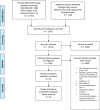The great vessel freeze-out: A meta-analysis of conventional versus frozen elephant trunks in aortic arch surgery
- PMID: 35526122
- PMCID: PMC9322650
- DOI: 10.1111/jocs.16596
The great vessel freeze-out: A meta-analysis of conventional versus frozen elephant trunks in aortic arch surgery
Abstract
Background: The optimal treatment strategy for complex aortic arch and proximal descending aortic pathologies remains controversial. Despite the frozen elephant trunk (FET) technique's increasing popularity, its use over the conventional elephant trunk (CET) remains a matter of physician preference and outcomes are varied.
Methods: This meta-analysis of available comparative studies of FET versus CET sought to examine differences in survival, reintervention, and adverse events. The following databases were searched from inception-May 2020: Ovid MEDLINE, Ovid EMBASE, and The Cochrane Library. Studies retrieved were then screened for eligibility against predefined inclusion/exclusion criteria with a protocol registered on Open Science Framework at https://osf.io/hrfze/.
Results: The search identified 1911 citations, with five studies included. The resultant meta-analysis included 313 CET and 292 FET cases. FET had lower perioperative mortality (risk ratio [RR]: 0.50, 95% confidence interval [CI]: [0.42; 0.60], p < .001) and improved 1-year survival compared to CET (hazard ratio: 0.63, 95% CI: [0.42; 0.95], p = .03). There were no significant differences in rates of overall or open reinterventions following FET versus CET, but FET did yield a significantly higher rate of endovascular reintervention (RR: 2.32, 95% CI: [1.17; 4.61], p = .03). No significant differences were observed in the incidences of postoperative stroke, spinal cord injury, or renal failure between groups.
Conclusions: The FET technique yields superior rates of perioperative and medium-term survival with no significant increase in overall reinterventions. There was no significant difference in the rate of spinal cord injury between groups, providing further large-scale evidence that the FET is an acceptable, safe alternative to the CET.
Keywords: aortic arch; elephant trunk; frozen elephant trunk; reintervention.
© 2022 The Authors. Journal of Cardiac Surgery published by Wiley Periodicals LLC.
Conflict of interest statement
The authors declare no conflicts of interest.
Figures





References
-
- Borst HG, Walterbusch G, Schaps D. Extensive aortic replacement using “elephant trunk” prosthesis. Thorac Cardiovasc Surg. 1983;31(1):37‐40. - PubMed
-
- Di Bartolomeo R, Murana G, Di Marco L, et al. Frozen versus conventional elephant trunk technique: application in clinical practice. European Journal of Cardiothoracic Surgery. 2017;51(suppl 1):i20‐i28. - PubMed
-
- Murphy EH, Stanley GA, Ilves M, et al. Thoracic endovascular repair (TEVAR) in the management of aortic arch pathology. Ann Vasc Surg. 2012;26(1):55‐66. - PubMed
-
- Rampoldi V, Trimarchi S, Eagle KA, et al. Simple risk models to predict surgical mortality in acute type A aortic dissection: the International Registry of Acute Aortic Dissection score. Ann Thorac Surg. 2007;83(1):55‐61. - PubMed
Publication types
MeSH terms
LinkOut - more resources
Full Text Sources
Medical

